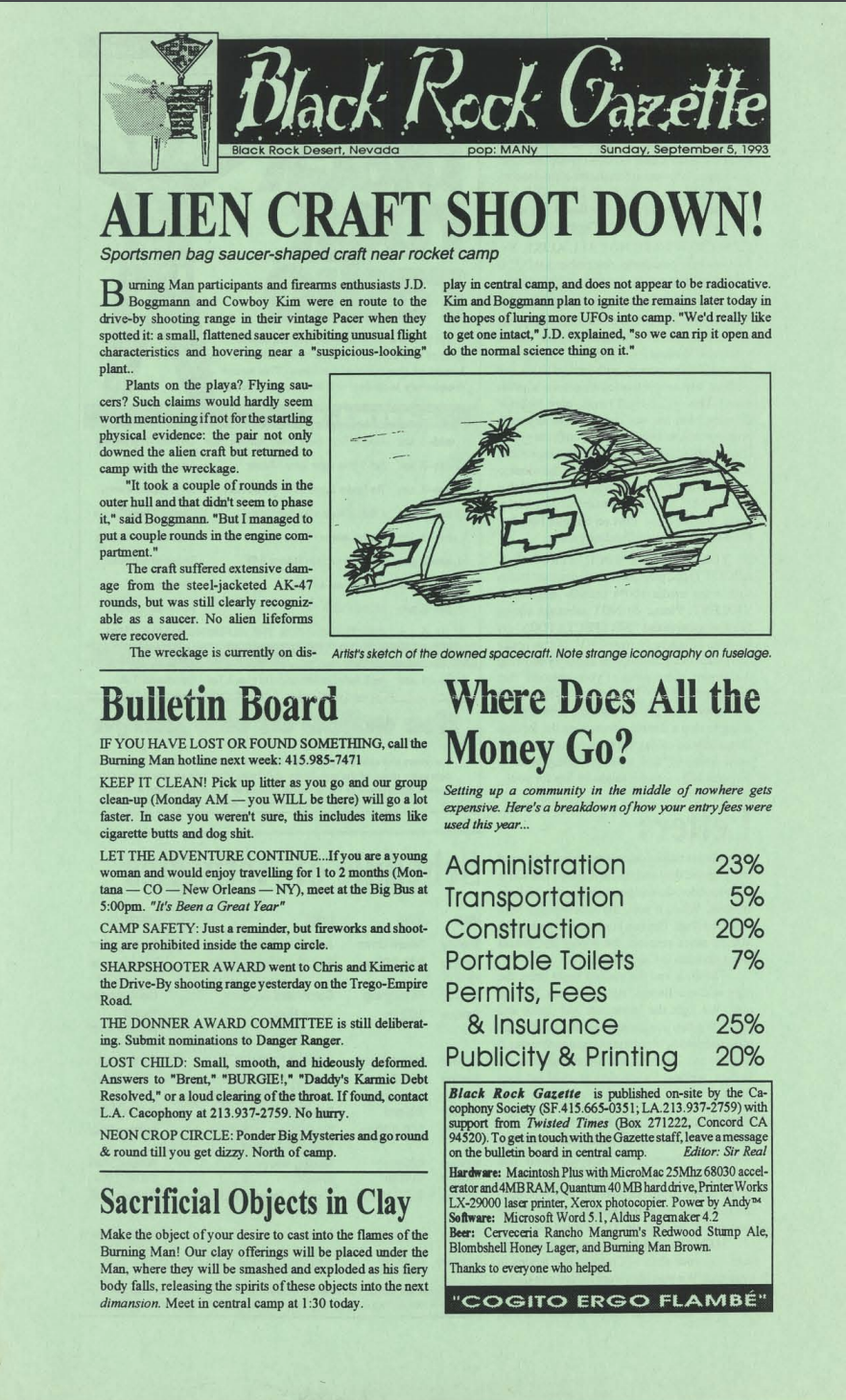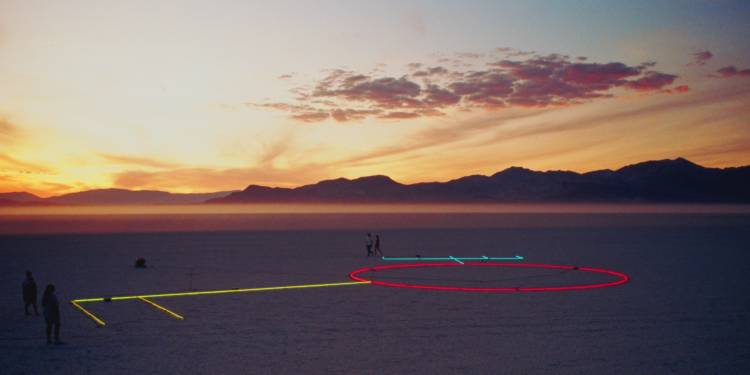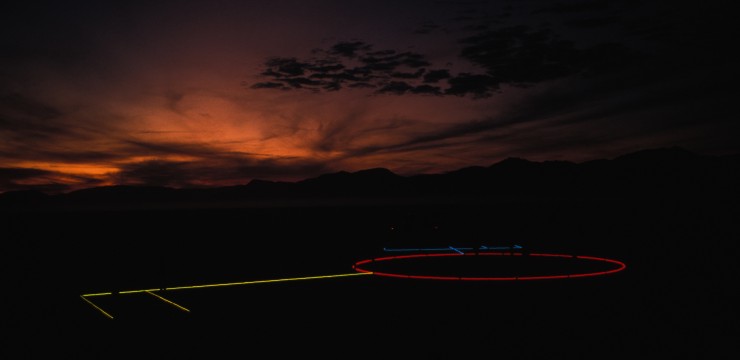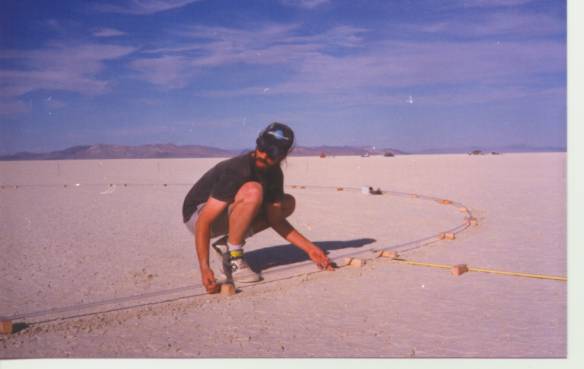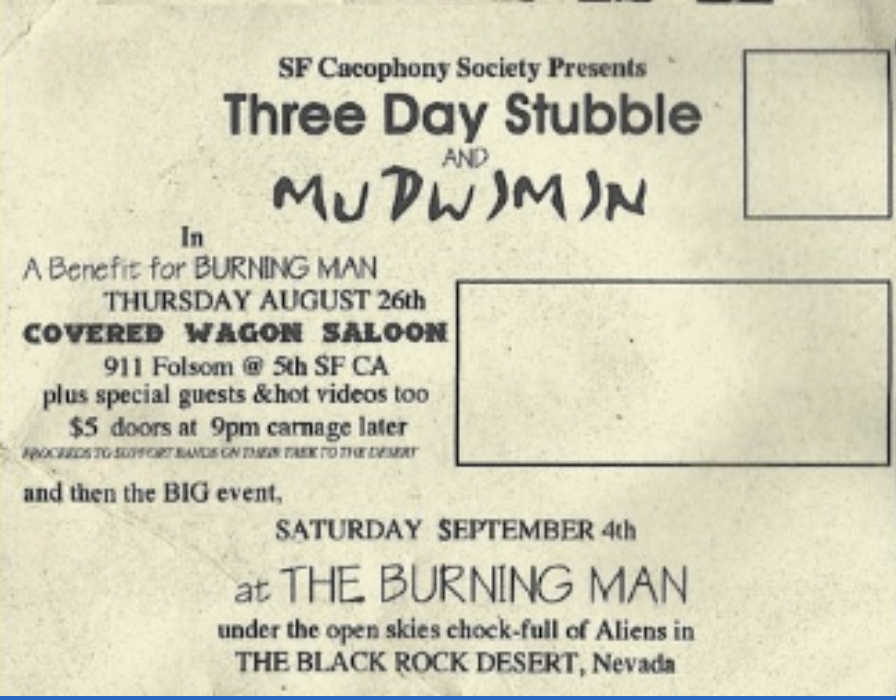Burning Man 1993
1993
Pepe Ozan’s Lingum
In 1993, around 1,000 people attended the Friday to Sunday event. It was the year in which many significant developments occurred that started to move Burning Man closer to the event it was to become, most notably the gathering featured a more formal city plan, an off-season magazine and a daily newspaper, and the Black Rock radio station. Perhapbs most notably, 1993 was the first year that Desert Siteworks was held - the event that ultimately lead to large scale art appearing at Burning Man.
Black Rock Town is Born
While calling it Black Rock City would be inaccurate, Black Rock Town is born, with all the infrastructure of a small community: A daily newspaper (the Black Rock Gazette), an off-season magazine (Building Burning Man), a radio station (Black Rock Radio: The Voice of the Playa), and a more formal city center. The procession to the burn was illuminated by lanterns placed by Steve Mobia - the seeds of the Lamplighter Ceremony.
The center of camp was more structured as well, with center camp being arranged in a circle: Gateways formed by pairs of sculptures marking the four compass points marked out an inner camp. Each sculpture consisted of potato mashers and commercial egg beaters (an art piece called Desert Navigational Locators, created by William Binzen). This inner circle was surrounded by an outer circle of vehicles and Port-a-Potties. At one end of the circle was the yellow Ryder truck used to bring the Man to the desert.
Center Camp Stage, Burning Man 1993
A banner demanding “No Specators” was hung on the side of a bus (which was quickly vandalized by the Billboard Liberation Front to read “NO S E TATORS”, but the slogan was restored and the banner above the center camp stage.
The Ryder truck had a structure affixed to it, consisting of “two sides, one ‘sacred’ the other ‘profane’.” The side of the structure facing the Man “formed a theatrical facade designed as a feminine counterpart to the admittedly phallic figure of the Man.” The “No Spectators” sign was hung above it. The other side of the central structure that faced away from the Man functioned as “a combination diner, cabaret and coffeehouse.”
To keep the community informed and interested in the off season, as well to solicit ticket orders, Building / Burning / Man magazine was circulated to the mailing list in the summer. At the event the Black Rock Gazette became a daily publication. Click on the images below to view the entire publications.
Desert Siteworks
Desert House, 1993 at DSW (later reconstructed at Burning Man)
From 1993 to 1995, William Binzen, a photographer, organized Desert Siteworks, which foretold the direction Burning Man would take. With the help of John Law and Michael Mikel, and other Cacophonists and artists he set up multi week encampments at area hot spring (each year a different one: Black Rock Hot Springs, Trego and then Frog a/k/a Bordello).
In 1992, the Cacophony Society started to put as much, if not more interest in Desert Siteworks than Burning Man. From the Cacophony Society: A huge area around Trego Hot Springs that had been a material storage for the railroad was repurposed (with the express intent of returning the area to its original condition) into a colossal art canvas containing over twenty earthworks and surface installations. Rituals, performances (for the participants only – there was no audience) and ongoing fabrication and modification of large-scale installations went on for ten days. These sessions in 1992 at Black Rock Springs, 1993 at Trego and 1994 at Frog Pond Springs at Garett Ranch pioneered the “Intentional Community” philosophy that informs and inspires the best components and participants of the Burning Man Festival to this day.
Art, Music and “Art Cars” on the Playa
William Binzen & Desert Siteworks
In 1993, art installation and live music became more central to the playa experience. William Binzen and Desert Siteworks influence on Larry Harvey was becoming evident as more large scale art appeared on the playa.
Larry Harvey found one piece particularly compelling, Authorities are Baffled, the desert’s first neon installation.
The simple act of encounter in an immense open space can be compelling. I remember one of my own first experiences with a large-scale work at our event in 1992. The artist, Vince Koloski, had installed a sprawling geometric pictogram upon the ground, mounting it six inches above the playa’s surface. It was composed of neon tubing in contrasting colors. I still recall my fascination as I walked around it in the dark. With each step, it seemed to reconfigure. It felt as if this object answered to my effort, as if my progress through the space were animating it. It soon became apparent that the Black Rock Desert’s stunning vacancy allowed participants to appropriate artworks as an element of their unique experience.
A Burning Man icon arrived for the first time on the playa: the Doggie Head. In the first year the Doggie Head (falsely rumored to be stolen) was part of a stage, designed to host live music. The Doggie head became a fixture at Burning Man for many years, and now three doggie heads are beloved icons in San Francisco.
Mudwimin performing in front of Doggie Head
The bands Three Day Stubble and Mudwimin played live sets throught the week on the Doggie Diner Stage.
Other art projects included:
The Oasis was a tent with an indoor recirculating water fountain adorned with plastic snakes housing Gregg Schlanger’s Waterway for Black Rock art installation
Lingam by Pepe Ozan (who would become one of the playa’s most significant early artists) debuted (photo at top). Ozan would bring Lingam back in different forms in multiple forms in future years.
Performance art included the return of Kimric Smthye, joined now by his wife, strapped with explosives to become the “Exploding Couple”
William Binzen build his “Desert House”, structure, which served as a center camp.
Harrod Blank and Oh My Gawd! Art Car, Burning Man 1993
The same year, Harrod Blank first attended Burning Man at the urging of his friend Michael Mikel, the owner of the playa’s first art car, the 5:04 Special. In 1992 Blank released “Wild Wheels” on the art car phenomenon. Blank used his deep connection in the art car world to bring more art cars to the playa, launching the “mutant vehicle” phenomenon at Burning Man.
Life on the Playa
Life on the playa was still loosely structured for much of the time. Driving on the playa, shooting guns and general tomfoolery was still the main attraction, but a more formal schedule of events was also forming.
Weekend Schedule
Friday… consisted of the initial raising of the Man (the Man would later be lowered and re-raised as had been done in prior years at BRC). Next up was a communal potluck dinner.
After dinner a slide show and lecture on the geological and archeological history of the desert by Billy Clewlow (who had discovered the largest mammoth ever found in North America near Black Rock Desert) was scheduled and well advertised….but did not occur.
Three Day Stubble
Cacophony Favorite and First Live Music at Burning Man
Saturday…just before sunset the Burning Man Fashion Show returned for a second year, followed by a live concert by Three Day Stubble. The show was followed by Kimric Smythe and his wife strapping explosives to themselves and igniting them, forming the “Incredible Exploding Couple”, followed by more live music by Mudwimmin. Finally, people could enjoy a “rave” at the music camp, which was returning for a second year and again was stations almost a mile away from the main camping area.
Sunday… started before dawn with the “Java Cow” ritual, in which Kimric would wear his Java Cow apparel, and hand out hot coffee at the base of the man. By the evening it was time to lower, and then ceremonially re-raise the Man, which was done by the community.
Crimson Rose and Will Rogers then did a fire show, which culminated with them lighting the Man. Another concert by Three Day Stubble and Mudwimin, followed by another trip to the “rave” camp for those that were inclined.
As in past years, much of the day would be spent talking, driving on the playa, and visiting the local hot springs. In 1993, the main source of noise during daytime hours were boom boxes playing cassette tapes, consisting primarily of rock music and experimental offshoots, with some punk and new wave music tossed into the mix. But in the evening, the hum of generators was becoming significant, evenings were featuring two live bands playing experimental music and punk rock, and late evenings the rave camp could be heard, despite being almost a mile away from center camp could
The no-commerce rule was not yet in effect. One report noted:
‘I'm looking for some shrooms. Anybody want to sell some?’ Enterprising entrepreneurs hawk Burning Man T-shirts and mugs. A woman with cleavage bulging from a black spandex animal-print getup straight out of Married ... With Children sells tacos fried on a full-sized gas stove. Dozens of generators hum beneath the din of dozens of battery powered boom boxes.
Wacky fun still included a formal cocktail party before the burn. Food now included faux formal dinner, served on fine china for some…. continuing the theme of general zany entertainment.
Java Cow
A Burning Man Ritual
Sunday morning featured the Java Cow ritual, where Kimric Smythe would arrive at the Man before dawn, and pour hot coffee. Right before dawn, people would head to the hot springs to watch the sunrise.
The Lightening Storm of 1993
“The Lightening Storm of 1993” was, by all accounts, impressive and disturbing. First the lightening began. The winds were high and the rain and dust combined for severe weather conditions. The precipitation initially was closer to tiny mud balls than rain, turning the playa into a sticky mud puddle. An HBO documentary team, who had just arrived to film Sunday’s festivities, panicked and made a run for it, a dangerous proposition in bad weather on the playa.
The First Theme Camp
Peter Doty
Peter Doty, Creator of the First Theme Camp
Peter Doty noted about early burns “It always surprised me that people were doing art out there. I didn’t think of it as something people would necessarily do. I thought of it as more of a camping trip/party type of thing. So anytime anybody did anything, it was like, “Oh, wow, someone did something!’. And back then, people actually slept at night. There weren’t a lot of generators. In 1991, I’m not sure there were any generators.”
Doty is generally recognized as creating Burning Man’s first theme camp, although some argue other groups such as the Bolt Action Rifle Club in 1990, pith-helmeted adventurers portraying the spirit of soldiers of the Raj with tea and authentic weaponry predated his efforts. Doty himself bows down before the efforts of Vivian Perry. She pulled of something he remembers as “Elegant Camp” Vivian “was going all out for elegance, and it blew everybody’s mind. She had a champagne bucket and fresh-cut flowers. She was eating oysters and caviar off china and silver, and it was all over-the-top extraneous and superfluous and completely inappropriate, and that was what was so wonderful about it.”
“Vivian was the talk of the playa. She managed to stay pristine the entire weekend…. Her white silk blouse was completely spotless, and her black velvet riding pants looked like they’d just come out of her drawer. Not even any dirt on her boots…. Turned out she was taking four showers a day and had multiple pieces of the same outfit; [she also] had a little damp rag she was carrying around, wiping of her boots constantly. We hadn’t seen anybody do anything so conceptually obsessive out there yet.”
Doty, with ideas supplied by Lisa Archer and Amanda Marshall, formed Christmas Camp in 1993 - He dressed as Santa, constantly blasted tapes of Christmas carols, festooned the camp with decorations, and supplied boozy eggnog.





